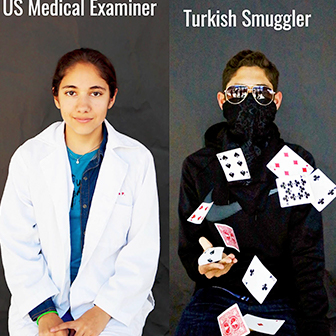Menu
PROJECT DESCRIPTION
INSTRUCTORS
SCHOOL SITE
LEVEL
SUBJECTS

“I was struck by how many “in between” places I found myself stuck in. There were points where I don’t think I was technically in any country, and I wondered where I was going to end up. I felt desperate and powerless.” — Simulation participant
In this student-created and student-run simulation, participants took on the roles of Syrian citizens forced to leave and seek refuge in another country.
Participants physically moved through the simulation from station to station, starting in Raqqa, Syria, where they were given their character information and their papers. This briefing was interrupted by ISIS members.
From here, participants had to sneak across the border to Turkey, get to a refugee camp, and decide whether to apply for resettlement overseas or pay a smuggler who promises to get them to Greece. At each station, characters based on real people were there to help or hinder their passage, and each of these characters had a story to tell.
This project was featured in the 2021 book Changing the Subject: Twenty Years of Projects from High Tech High. You can learn more about the book and the projects within by visiting the official website.

As a humanities teacher and coordinator of a Shakespeare club, Alec Patton had put on many plays with students, but never a role-playing simulation. At the project’s beginning, he still hadn’t decided whether the final exhibition would be a play or a simulation. He got together with some students who planned a project launch: Alec stood up in front of the class and announced a pop quiz, while a group of black-hooded intruders quietly entered from the back, then seized control of the class. They announced that students had to make a choice: stay under their new regime, or flee, and then explained this was what it would be like for their participants if they decided to design a simulation.
The project began with common readings about Syria, the refugee crisis, and some powerful journalistic accounts of refugees’ journeys. At the same time, the team explored simulations and role-playing games. Many of the students were far more expert than Alec in these; they told him about a video game called “This War of Mine,” in which the object is to survive the siege of Sarajevo, which seemed like it could serve as a rough model for what they hoped to create.
After the students gathered some background information, small groups were each assigned an article about an individual refugee’s journey. They were tasked with annotating and mapping each step of the journey geographically, as well as why they left, and what decisions they were faced with. Each group brought their refugee’s story to a class-wide mapping session in which all of the paths were mapped out on a giant whiteboard. The class could then step back and look at which routes were most heavily traveled.
The mapping process led directly to the game design: once the students had decided upon the most common stops and the decisions faced at each step of the journey, they divided themselves into station groups. For each station (such as the Turkish border, or a refugee camp), students created maps, decision tree diagrams, character narratives, and narratives describing context, institutions, and laws.
As the students developed their stations, they ran intensive playtests (simulation practices), critiques, and revisions. Finally, they were ready for a full simulation playtest, final revision, and exhibition.
The group was lucky to have more than one opportunity to run the simulation. The first took place at the school-wide Fiesta del Sol, where families, community members, and K-12 students participated. A second took place for students at another HTH campus. At the end of the simulation, students set up de-briefing stations, where participants could share their responses and ask questions about the content and the process.

